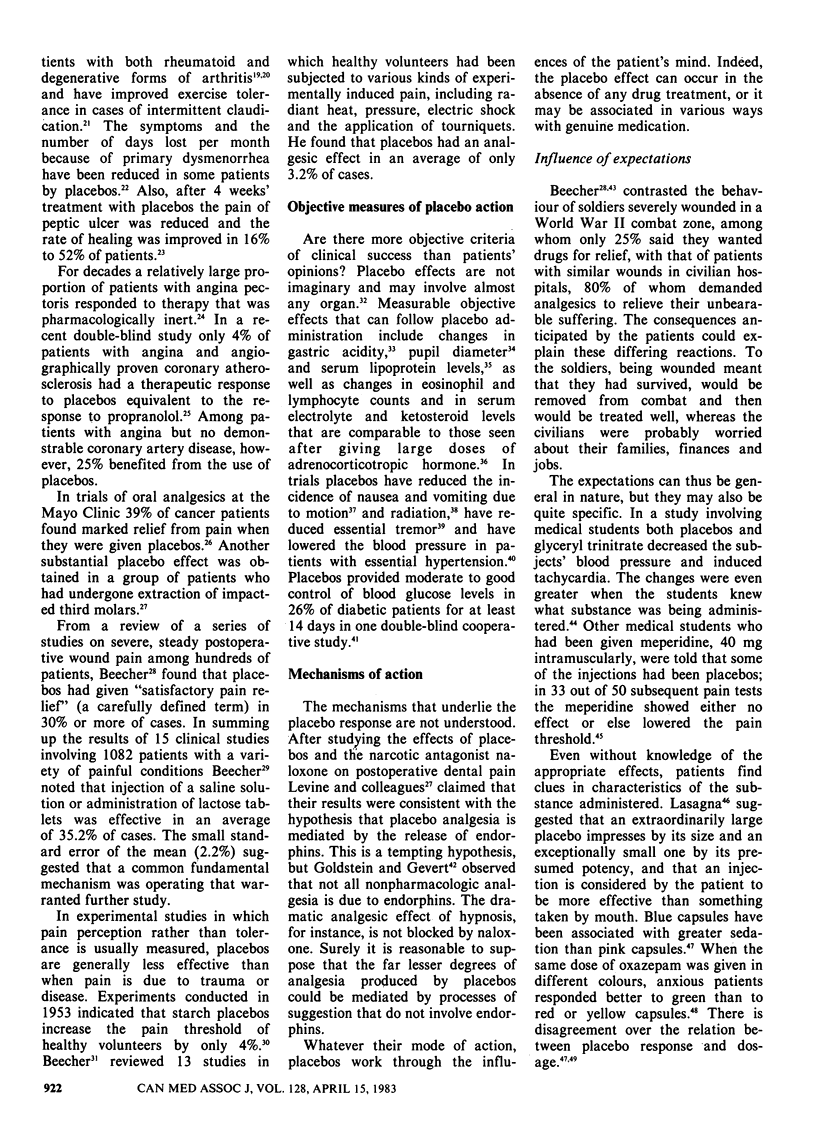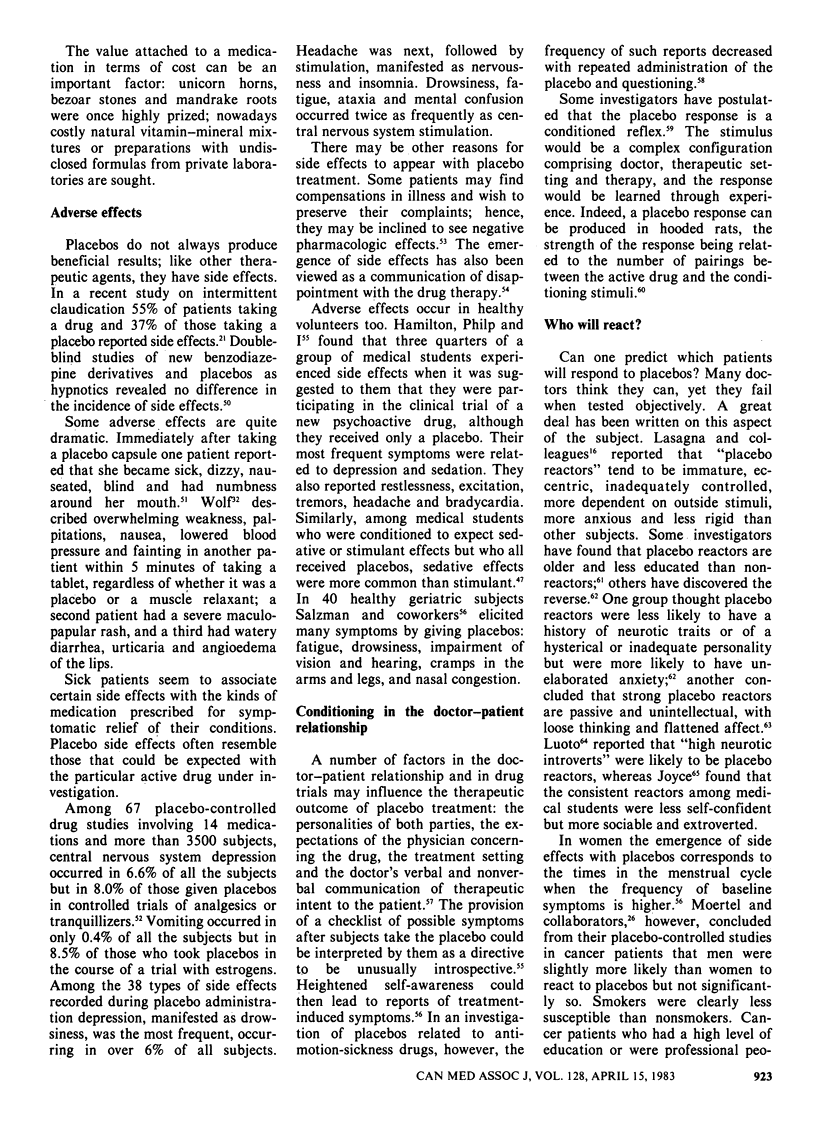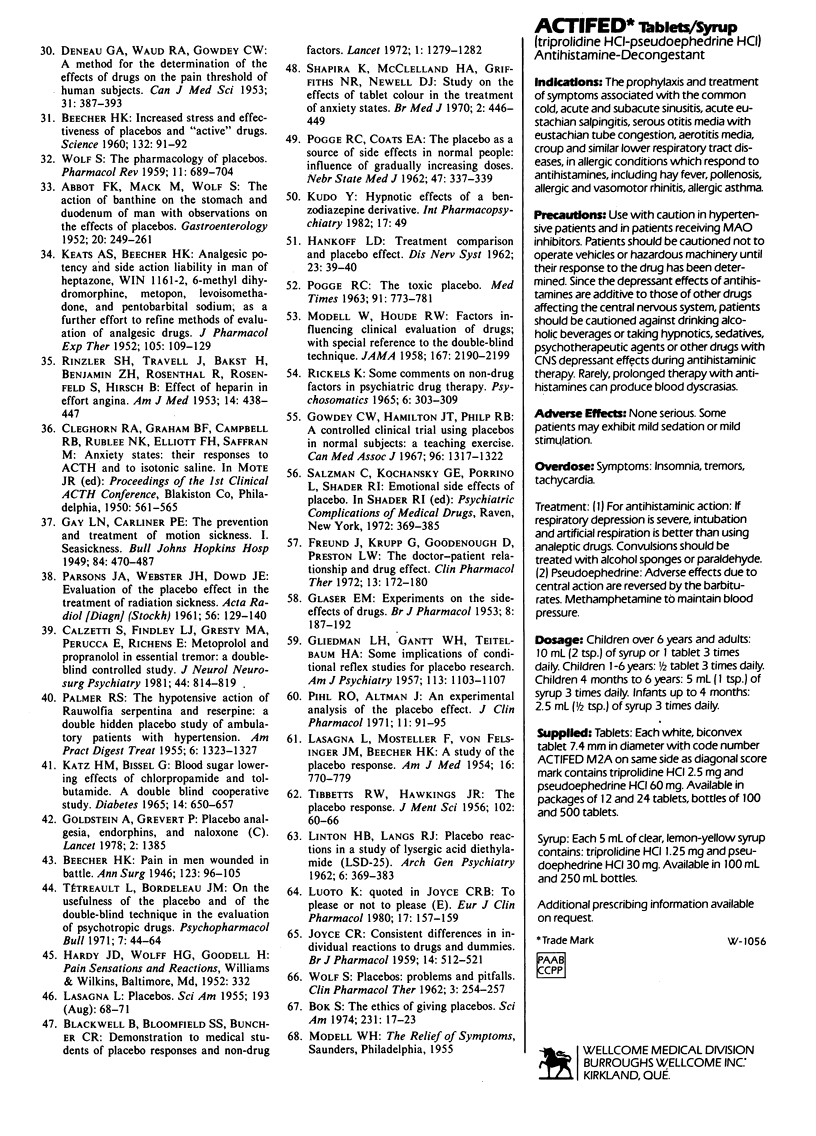Abstract
The placebo effect is capable of relieving pain in a substantial proportion of patients; affective disorders also respond to the administration of inert medication. Changes in objective measures, such as blood pressure and blood glucose levels, demonstrate the action of placebos. The underlying mechanisms are not yet known, but because the nature and strength of the placebo response are governed by the patient's perceptions, both positive and negative results may be obtained. The complexity of human perception has made it extremely difficult to characterize the people who react. In clinical situations the placebo may be underused as a therapeutic agent, while in clinical trials the effect may be inadequately evaluated; the power and nature of the placebo effect truly warrant greater recognition.
Full text
PDF




Selected References
These references are in PubMed. This may not be the complete list of references from this article.
- ABBOT F. K., MACK M., WOLF S. The action of banthine on the stomach and duodenum of man with observations on the effects of placebos. Gastroenterology. 1952 Feb;20(2):249–261. [PubMed] [Google Scholar]
- Amsterdam E. A., Wolfson S., Gorlin R. New aspects of the placebo response in angina pectoris. Am J Cardiol. 1969 Sep;24(3):305–306. doi: 10.1016/0002-9149(69)90422-6. [DOI] [PubMed] [Google Scholar]
- BEECHER H. K. Increased stress and effectiveness of placebos and "active" drugs. Science. 1960 Jul 8;132(3419):91–92. doi: 10.1126/science.132.3419.91. [DOI] [PubMed] [Google Scholar]
- BUCK C., GOWDEY C. W. A clinical trial of a quaternary ammonium antiseptic lozenge in the treatment of the common cold. Can Med Assoc J. 1962 Mar 17;86:489–491. [PMC free article] [PubMed] [Google Scholar]
- Beecher H. K. Pain in Men Wounded in Battle. Ann Surg. 1946 Jan;123(1):96–105. [PMC free article] [PubMed] [Google Scholar]
- Blackwell B., Bloomfield S. S., Buncher C. R. Demonstration to medical students of placebo responses and non-drug factors. Lancet. 1972 Jun 10;1(7763):1279–1282. doi: 10.1016/s0140-6736(72)90996-8. [DOI] [PubMed] [Google Scholar]
- Bok S. The ethics of giving placebos. Sci Am. 1974 Nov;231(5):17–23. doi: 10.1038/scientificamerican1174-17. [DOI] [PubMed] [Google Scholar]
- Brogden R. N., Carmine A. A., Heel R. C., Speight T. M., Avery G. S. Ranitidine: a review of its pharmacology and therapeutic use in peptic ulcer disease and other allied diseases. Drugs. 1982 Oct;24(4):267–303. doi: 10.2165/00003495-198224040-00002. [DOI] [PubMed] [Google Scholar]
- Budoff P. W. Zomepirac sodium in the treatment of primary dysmenorrhea syndrome. N Engl J Med. 1982 Sep 16;307(12):714–719. doi: 10.1056/NEJM198209163071203. [DOI] [PubMed] [Google Scholar]
- Calzetti S., Findley L. J., Gresty M. A., Perucca E., Richens A. Metoprolol and propranolol in essential tremor: a double-blind, controlled study. J Neurol Neurosurg Psychiatry. 1981 Sep;44(9):814–819. doi: 10.1136/jnnp.44.9.814. [DOI] [PMC free article] [PubMed] [Google Scholar]
- DENEAU G. A., WAUD R. A., GOWDEY C. W. A method for the determination of the effects of drugs on the pain threshold of human subjects. Can J Med Sci. 1953 Oct;31(5):387–393. doi: 10.1139/cjms53-040. [DOI] [PubMed] [Google Scholar]
- Freund J., Krupp G., Goodenough D., Preston L. W. The doctor-patient relationship and drug effect. Clin Pharmacol Ther. 1972 Mar-Apr;13(2):172–180. doi: 10.1002/cpt1972132172. [DOI] [PubMed] [Google Scholar]
- GLASER E. M. Experiments on the side-effects of drugs. Br J Pharmacol Chemother. 1953 Jun;8(2):187–192. doi: 10.1111/j.1476-5381.1953.tb00776.x. [DOI] [PMC free article] [PubMed] [Google Scholar]
- GLIEDMAN L. H., GANTT W. H., TEITELBAUM H. A. Some implications of conditional reflex studies for placebo research. Am J Psychiatry. 1957 Jun;113(12):1103–1107. doi: 10.1176/ajp.113.12.1103. [DOI] [PubMed] [Google Scholar]
- Goldstein A., Grevert P. Placebo analgesia, endorphins, and naloxone. Lancet. 1978 Dec 23;2(8104-5):1385–1385. doi: 10.1016/s0140-6736(78)92026-3. [DOI] [PubMed] [Google Scholar]
- Goodwin J. S., Goodwin J. M., Vogel A. V. Knowledge and use of placebos by house officers and nurses. Ann Intern Med. 1979 Jul;91(1):106–110. doi: 10.7326/0003-4819-91-1-106. [DOI] [PubMed] [Google Scholar]
- Gowdey C. W., Hamilton J. T., Philp R. B. A controlled clinical trial using placebos in normal subjects: a teaching exercise. Can Med Assoc J. 1967 May 13;96(19):1317–1322. [PMC free article] [PubMed] [Google Scholar]
- HANKOFF L. D. Treatment comparison and the placebo effect. Dis Nerv Syst. 1962 Jan;23:39–40. [PubMed] [Google Scholar]
- HILLIS B. R. The assessment of cough suppressing drugs. Lancet. 1952 Jun 21;1(6721):1230–1235. doi: 10.1016/s0140-6736(52)92060-6. [DOI] [PubMed] [Google Scholar]
- JOYCE C. R. Consistent differences in individual reactions to drugs and dummies. Br J Pharmacol Chemother. 1959 Dec;14:512–521. doi: 10.1111/j.1476-5381.1959.tb00958.x. [DOI] [PMC free article] [PubMed] [Google Scholar]
- KEATS A. S., BEECHER H. K. Analgesic potency and side action liability in man of heptazone, WIN 1161-2, 6-methyl dihydromorphine, Metopon, levo-isomethadone and pentobarbital sodium, as a further effort to refine methods of evaluation of analgesic drugs. J Pharmacol Exp Ther. 1952 Jun;105(2):109–129. [PubMed] [Google Scholar]
- Katz H. M., Bissel G. Blood sugar lowering effects of chlorpropamide and tolbutamide. A double blind cooperative study. Diabetes. 1965 Oct;14(10):650–657. doi: 10.2337/diab.14.10.650. [DOI] [PubMed] [Google Scholar]
- LASAGNA L., MOSTELLER F., VON FELSINGER J. M., BEECHER H. K. A study of the placebo response. Am J Med. 1954 Jun;16(6):770–779. doi: 10.1016/0002-9343(54)90441-6. [DOI] [PubMed] [Google Scholar]
- LASAGNA L., VON FELSINGER J. M., BEECHER H. K. Drug-induced mood changes in man. I. Observations on healthy subjects, chronically ill patients, and postaddicts. J Am Med Assoc. 1955 Mar 19;157(12):1006–1020. doi: 10.1001/jama.1955.02950290026009. [DOI] [PubMed] [Google Scholar]
- LESLIE A. Ethics and practice of placebo therapy. Am J Med. 1954 Jun;16(6):854–862. doi: 10.1016/0002-9343(54)90450-7. [DOI] [PubMed] [Google Scholar]
- LINTON H. B., LANGS R. J. Placebo reactions in a study of lysergic acid diethylamide (LSD-25). Arch Gen Psychiatry. 1962 May;6:369–383. doi: 10.1001/archpsyc.1962.01710230037004. [DOI] [PubMed] [Google Scholar]
- Levine J. D., Gordon N. C., Fields H. L. The mechanism of placebo analgesia. Lancet. 1978 Sep 23;2(8091):654–657. doi: 10.1016/s0140-6736(78)92762-9. [DOI] [PubMed] [Google Scholar]
- MODELL W., HOUDE R. W. Factors influencing clinical evaluation of drugs; with special reference to the double-blind technique. J Am Med Assoc. 1958 Aug 30;167(18):2190–2199. doi: 10.1001/jama.1958.72990350005006. [DOI] [PubMed] [Google Scholar]
- MOLLING P. A., LOCKNER A. W., Jr, SAULS R. J., EISENBERG L. Committed delinquent boys. The impact of perphenazine and of placebo. Arch Gen Psychiatry. 1962 Jul;7:70–76. doi: 10.1001/archpsyc.1962.01720010072009. [DOI] [PubMed] [Google Scholar]
- MORISON R. A., WOODMANSEY A., YOUNG A. J. Placebo responses in an arthritis trial. Ann Rheum Dis. 1961 Jun;20:179–185. doi: 10.1136/ard.20.2.179. [DOI] [PMC free article] [PubMed] [Google Scholar]
- Malitz S., Kanzler M. Are antidepressants better than placebo? Am J Psychiatry. 1971 Jun;127(12):1605–1611. doi: 10.1176/ajp.127.12.1605. [DOI] [PubMed] [Google Scholar]
- Moertel C. G., Taylor W. F., Roth A., Tyce F. A. Who responds to sugar pills? Mayo Clin Proc. 1976 Feb;51(2):96–100. [PubMed] [Google Scholar]
- O'Brien P. M. The premenstrual syndrome: a review of the present status of therapy. Drugs. 1982 Aug;24(2):140–151. doi: 10.2165/00003495-198224020-00004. [DOI] [PubMed] [Google Scholar]
- OLSON G. W., PETERSON D. B. Intermittent chemotherapy for chronic psychiatric inpatients. J Nerv Ment Dis. 1962 Feb;134:145–149. doi: 10.1097/00005053-196202000-00005. [DOI] [PubMed] [Google Scholar]
- PALMER R. S. The hypotensive action of Rauwolfia serpentina and reserpine: a double hidden placebo study of ambulatory patients with hypertension. Am Pract Dig Treat. 1955 Sep;6(9):1323–1327. [PubMed] [Google Scholar]
- PARSONS J. A., WEBSTER J. H., DOWD J. E. Evaluation of the placebo effect in the treatment of radiation sickness. Acta radiol. 1961 Aug;56:129–140. doi: 10.3109/00016926109176647. [DOI] [PubMed] [Google Scholar]
- POGGE R. C., COATS E. A. The placebo as a source of side effects in normal people: influence of gradually increasing doses. Nebr State Med J. 1962 Jun;47:337–339. [PubMed] [Google Scholar]
- POGGE R. C. The toxic placebo. II. The case of the partial patient. Med Times. 1963 Aug;91:778–781. [PubMed] [Google Scholar]
- Pihl R. O., Altman J. An experimental analysis of the placebo effect. J Clin Pharmacol New Drugs. 1971 Mar-Apr;11(2):91–95. doi: 10.1177/009127007101100203. [DOI] [PubMed] [Google Scholar]
- Porter J. M., Cutler B. S., Lee B. Y., Reich T., Reichle F. A., Scogin J. T., Strandness D. E. Pentoxifylline efficacy in the treatment of intermittent claudication: multicenter controlled double-blind trial with objective assessment of chronic occlusive arterial disease patients. Am Heart J. 1982 Jul;104(1):66–72. doi: 10.1016/0002-8703(82)90642-1. [DOI] [PubMed] [Google Scholar]
- RINZLER S. H., TRAVELL J., BAKST H., BENJAMIN Z. H., ROSENTHAL R. L., ROSENFELD S., HIRSCH B. B. Effect of heparin in effort angina. Am J Med. 1953 Apr;14(4):438–447. doi: 10.1016/0002-9343(53)90200-9. [DOI] [PubMed] [Google Scholar]
- Rickels K. Some comments on non-drug factors in psychiatric drug therapy. Psychosomatics. 1965 Sep-Oct;6(5):303–309. doi: 10.1016/s0033-3182(65)72242-1. [DOI] [PubMed] [Google Scholar]
- STRAUS B., EISENBERG J., GENNIS J. Hypnotic effects of an antihistamine; methapyrilene hydrochloride. Ann Intern Med. 1955 Mar;42(3):574–582. doi: 10.7326/0003-4819-42-3-574. [DOI] [PubMed] [Google Scholar]
- Schapira K., McClelland H. A., Griffiths N. R., Newell D. J. Study on the effects of tablet colour in the treatment of anxiety states. Br Med J. 1970 May 23;1(5707):446–449. doi: 10.1136/bmj.2.5707.446. [DOI] [PMC free article] [PubMed] [Google Scholar]
- Sillanpä M. Clonidine prophylaxis of childhood migraine and other vascular headache. A double blind study of 57 children;. Headache. 1977 Mar;17(1):28–31. doi: 10.1111/j.1526-4610.1977.hed1701028.x. [DOI] [PubMed] [Google Scholar]
- TIBBETTS R. W., HAWKINGS J. R. The placebo response. J Ment Sci. 1956 Jan;102(426):60–66. doi: 10.1192/bjp.102.426.60. [DOI] [PubMed] [Google Scholar]
- TRAUT E. F., PASSARELLI E. W. Placebos in the treatment of rheumatoid arthritis and other rheumatic conditions. Ann Rheum Dis. 1957 Mar;16(1):18–22. doi: 10.1136/ard.16.1.18. [DOI] [PMC free article] [PubMed] [Google Scholar]
- Tétreault L., Bordeleau J. M. On the usefulness of the placebo and of the double-blind technique in the evaluation of psychotropic drugs. Psychopharmacol Bull. 1971 Jul;7(3):44–64. [PubMed] [Google Scholar]
- WOLF S., PINSKY R. H. Effects of placebo administration and occurrence of toxic reactions. J Am Med Assoc. 1954 May 22;155(4):339–341. doi: 10.1001/jama.1954.03690220013004. [DOI] [PubMed] [Google Scholar]
- WOLF S. Symposium on clinical drug evaluation and human pharmacology. IV. Placebos: problems and pitfalls. Clin Pharmacol Ther. 1962 Mar-Apr;3:254–257. doi: 10.1002/cpt196232254. [DOI] [PubMed] [Google Scholar]
- WOLF S. The pharmacology of placebos. Pharmacol Rev. 1959 Dec;11:689–704. [PubMed] [Google Scholar]


